Industry Outlook: Telehandlers
Safety, connectivity and versatilty are driving developments in new telehandler models.
Telehandlers are gaining popularity because of their versatility. They are usually one of the first pieces of equipment on a job site and one of the last to leave. With the right
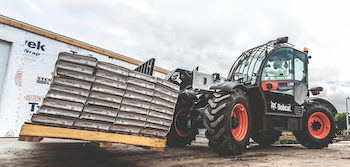 |
| As with other compact equipment, telehandler attachment options are a great opportunity for rental houses to increase ROI. Telehandlers can be paired with a wide range of attachments, from augers and buckets to grapples and pallet forks. Multiple attachments can bring in more revenue by keeping the machine out for rent for longer periods of time. |
attachments, they can do load-and carry jobs, then place materials and manpower at heights and then make cleanup chores easy as the project comes to close. Industry experts share how these units are changing and becoming even more valuable to rental centers and their customers.
Safety, service key rental attributes
Speaking only about Merlo telehandlers, there are a number of factors coming into play when it comes to trends. First, the increased safety features available on all Merlo telehandlers include intuitive overload protection system with highly visible warning lights and alarms. The systems are a very important safety feature, especially when one does not know the level of experience or familiarity of the operator with the equipment.
 |
| GARTH MCGILLEWIE President AMS-Merlo |
Second is the access to serviceability. Merlo telehandlers have onboard diagnostics, so these machines are easy to service in the yard or on the job site.
Third, users are demanding machines with higher lift and weight capacity while still retaining a compact footprint. For example, the Merlo R50.35 S Plus rotating telehandler model with its 115-foot lift and the R70.28 S Plus with a 15,400-pound maximum operating capacity fulfill these needs.
Fourth, customers are wanting more from a machine. Enclosed cabs with heat and air conditioning mean an operator can work all year in comfort, which leads to more productivity. Controls that are more ergonomic means an operator can work longer. Tilt cabs on Merlo Roto models mean an operator can keep an eye on the load and low-pivot booms on all Merlo models ensure better operator sight lines at all times.
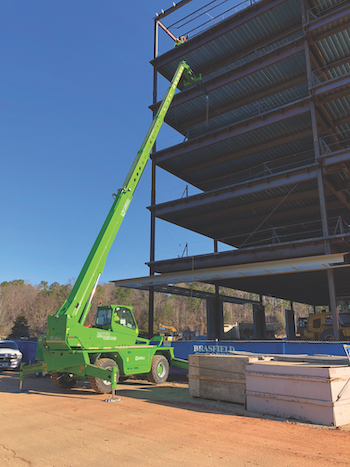 |
| New telehandlers feature intuitive overload protection systems with its highly visible warning lights and alarms. |
A number of rental outfits are telling us they are seeing an uptick in construction customers requesting machines that offer more. They are looking for higher lifts, more weight capacity, better safety features, easier and more intuitive operator controls, compact footprints even with stabilizers deployed, and tighter turning ratios. These requests are common from companies working on urban construction sites.
Rental centers can increase demand and ROI with these units by asking questions and becoming more of a consultant to the end user. Promote the positives such as the safety features; low pivot booms for better sight lines; compact footprint, even with stabilizers in use; tight turning ratios; and all the safety features that enable an operator to maximize a machine’s capabilities.
Rental centers are finding that customers need training, so they should make training a part of the rental package. To optimize a telehandler’s performance, it’s important that the person operating the machine is optimized as well, being comfortable with getting from the machine all it has to offer.
Attachments extend telehandler versatility
Telehandlers continue to be a smart choice for rental companies because of their versatility, exceptional reach and lift capacity in many applications. Compact models provide renters with more flexibility when working in tight spaces, as well as open areas without stepping up to a larger machine. These machines are quite common in various construction applications – both commercially and residentially.
 |
|
PETER ATTERBERG |
For instance, the Bobcat V723 and new V923 VersaHandler telescopic tool carriers are a good fit for rental centers. The 100-horsepower V723 and 130-horsepower V923 pack a powerful punch for rental customers. The V723 offers an increased rated operating capacity of 7,700 pounds and the V923 with 9,000 pounds for more productivity with every lift cycle and unbeatable pushing strength. Both are equipped with a simple, state-of-the-art non-DPF Tier 4-compliant engine. This reduces downtime that occurs with DPF regeneration and long-term DPF maintenance costs so customers can focus on working.
In addition, Bobcat telehandlers have a heavy-duty hydrostatic transmission that delivers more speed, quick power and high wheel torque for digging and pushing.
Rental customers will also appreciate three steering and travel modes for application-matched maneuverability. An automatic ride-control feature reduces material spillage, allowing operators to travel at faster speeds for increased productivity. Plus, the power Quick-Tach attachment mounting system helps increase attachment utilization.
Customers also appreciate the load-sense hydraulic system that is designed for faster boom speeds and heavier lifting. It gives operators extra power for smoother control when loaded and the fastest boom cycle times possible when empty.
The patented hydraulic lift system provides advanced high-flow technology to optimize lift capabilities while providing high-speed movement and multifunctioning performance during the lift cycle.
Operators can enable boom float while back-grading or smoothing uneven ground. Its Z-bar boom linkage delivers greater range of bucket rotation, an increased dump angle at full height and increased breakout force to lift material out of a pile and dump it easily.
In addition, the V723 and V923 models have an Eco mode that can help save on fuel costs. The Eco mode optimizes engine performance for reduced fuel consumption and can easily be turned on and off be activating a toggle switch cab.
Ease of operation is another important telehandler trend and is beneficial for rental customers. For instance, the V723 and V923 offer a single intuitive joystick so operators can control several functions, including travel direction, lift and tilt functions, boom extension and auxiliary hydraulics with one hand.
As with other compact equipment, telehandler attachment options are a great opportunity for rental houses to increase ROI. Telehandlers can be paired with a wide range of attachments – from augers and buckets to grapples and pallet forks. Multiple attachments can bring in more revenue by keeping the machine our for rent for longer periods of time. In addition to extended rental times, rental attachments can help customers diversify their fleet and give them the opportunity to complete more jobs.
Telematics improves telehandler ROI
One technology that is being adopted industry-wide across all rental products, including telehandlers, is telematics. Telematics allows fleet owners to see real-time data about the machine while it is on site, improving the ability to track service and maintenance needs, optimize delivery and pickup routes and become more efficient ways that were not possible before. Many large rental companies are already leveraging these advantages and adoption is becoming more widespread among independent and smaller rental houses as well.
 |
| JOSH TAYLOR Genie Product Manager Terex AWP |
In 2019, Genie introduced Lift Connect as a standard feature on new Genie telehandlers. Genie Lift Connect provides information that allow rental fleet and service managers to take action through a variety of tools, including ability to view the entire fleet, receive alerts, see maintenance that is due, set geo-zones and more.
In North America, telehandlers generally enjoy very high utilization due to their versatility. Knowing your customer base and the type of projects happening in your area can help ensure that you have the right size machines in your fleet.
In terms of reducing cost of ownership, following regular maintenance schedules is the best way to prevent unwanted downtime. Having a mix of configurations, such as some units with an enclosed cab and HVAC system, can also increase fleet ROI. Some regions see a higher rental rate during hot or cold months with these configurations.
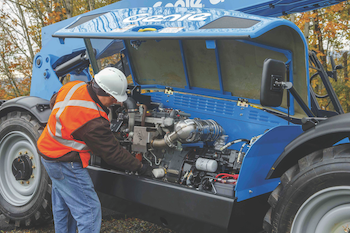 |
| Telehandlers excel at load-and-carry jobs. Rental center personnel should work closely with customers to understand the jobs they want to do with a telehandler and what weight and height ranges that are needed on the job so the customer rents the right size of unit. |
One thing that Genie experts emphasize consistently is keeping up on scheduled maintenance. This includes everything from daily walk-around inspections to regular filter and fluid changes. Performing small repairs as they pop up and performing incremental maintenance can prevent premature wear in components and systems that can become costly if they are left to fail. The cost of major repairs is often twofold: the cost or quantity of repair parts is higher and the cost of lost revenue is higher due to the increased down time. The old adage, “an ounce of prevention is worth a pound of cure,” could certainly be applied.
Telematics and operator upgrades help ROI
We are seeing two primary areas of change in the telehandler market: telematics systems and operator enhancements.
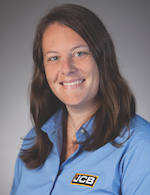 |
|
REBECCA YATES |
Owners and operators want to know more about the usage and productivity of the machines, and telematic systems can now provide that.
JCB includes its LiveLink telematics system with all telehandlers, which includes a five-year subscription.
JCB LiveLink can support service diagnostics, provide reports on idle time and fuel efficiency to communicate if a machine could be used on multiple sites or more jobs, as well as security features to keep your investment safe with tracking and alerts.
Customers are also asking for additional features to enhance visibility around work areas. Some of those features are back-up cameras with multifunctional displays, indicators such as a green beacon that shows if an operator is wearing a seat belt from a distance, or a brightly colored seatbelt.
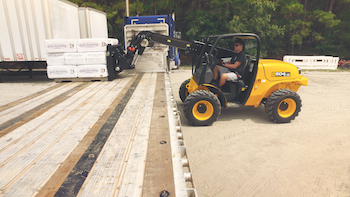 |
|
The 2-ton JCB 19C-1E is ideally suited to excavation applications on enclosed or urban job sites, or noise- and emissions-sensitive environments such as hospitals and schools. JCB research indicates that electric charging costs for the 19C-1E are 50 percent lower than fuel costs for a comparable diesel powered machine over a five-year ownership period. |
Telehandlers are essential on any job site as the primary piece of equipment to get materials to the proper spot so the job keeps moving and productivity remains high. JCB offers a number of different types of telehandlers to support the needs of the market including the tool-carrier models that can lift material to height but are also designed to use a bucket to dig into a pile of gravel that needs distributed or support site grading.
Being able to offer more specialized options can help generate new opportunities. For example, JCB offers non-marking tires for most telehandler models, which could be used on new job sites or at entertainment facilities or parks where it’s important to keep the area clean.
Additional options, like positive air shut-off valves that allow for work around oil and gas fields, or arctic packages to work in harsh cold environments, are available to maximize the capabilities of the machine.
To ensure customer satisfaction, it is important to recommend the correct size of telehandler.
It’s important to ask the weight of the material being lifted and to what height the material needs to be placed. Most telehandlers in the market today have a model number that indicates a maximum capacity, but that can be deceiving.
If a customer needs to lift material that weighs 4,000 pounds, a smaller telehandler, like the JCB 505-20TC, might be recommended. However, if that 4,000 pounds needs to be placed up to a height of 30 feet, the customer might actually need to rent a larger model like a JCB 510-56 telehandler model.
Understanding a load chart and how to read is something a rental center can do to help a customer make sure they’re renting the appropriate machine for their job.
Connected equipment
There are a multitude of trends impacting design, development, features, functions and benefits of construction equipment. One such trend that affects telehandlers is connectivity. The internet of things (IoT) is changing how equipment companies develop equipment and how equipment interacts with each other, operators and technicians.
 |
|
JOHN BOEHME |
For operators and owners, equipment is becoming more connected, allowing it to provide valuable data throughout the workday for decision making and planning purposes. For rental companies, this connectivity can help improve fleet utilization, maintenance, serviceability and uptime.
A clear example on a JLG telehandler would be SmartLoad technology, which is a bundle of three technologies that work together to increase operator confidence and optimize productivity. This award-winning, industry-first system includes automatic attachment recognition, a load management information system and a load stability indicator.
Another trend impacting telehandler design is urbanization. New buildings are becoming taller and placed closer together. This is driving demand for small-footprint telehandlers like the new super-compact JLG SkyTrak 3013 and higher reaching machines such as the new JLG 1075, with eight-story lift height, 30-foot up-and-over reach and 60-foot forward reach.
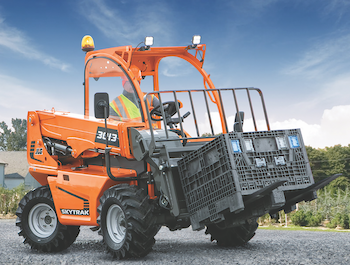 |
| The most common challenge with telehandlers from a customer perspective is selecting the right machine for the job. Rental centers should be prepared to ask their rental customer detailed questions about the work that needs to be completed. |
Although not specific to telehandlers, digital solutions are expanding in the initial design and planning stages through finish work. These solutions are making job sites more efficient and include BIM modeling and augmented reality apps, such as the one demonstrated by JLG at ConExpo. They help rental companies and contractors plan for and select the right equipment for the work at hand.
Rental centers are focused on return on investment (ROI) as defined not only by the initial acquisition cost, but the total cost of the product over its lifetime. Rental company owners and owner/operators are paying more attention to the versatility of each piece of equipment, the productivity gains the telehandler can provide with its new technology and digital solutions and any after-the-sale costs. Rental centers can charge a premium for units equipped with technology that deliver tangible value to the end-user customer. Understanding and being able to clearly communicate the value of a telehandler equipped with new technologies and features that improve productivity and safety will help expedite user adoption and build demand.
In the age of big data, the adoption and use of telematics systems continues along its growth trajectory. The JLG ClearSky fleet management telematics solution provides equipment owners and operators access to critical engine and equipment operational data so they can make better decisions on their investment. Data points – including location, engine hours, usage, fuel and battery levels and maintenance schedules – are conveniently available in real-time and accessible from desktop or mobile devices. The system also monitors fault codes and other critical alerts so maintenance can be proactively managed to reduce unplanned downtime.
The most common challenge with telehandlers from a customer perspective is selecting the right machine for the job. Rental centers should be prepared to ask their rental customer detailed questions about the work that needs to be completed. They need to understand how much weight will require lifting and how much reach is needed to place the load. These two criteria are the starting point in selecting the right model.
Telehandlers are typically the first machines on the job site and the last to leave. The applications for these machines vary greatly from the initial phases of a large construction project, where the machines can be found unloading trucks and delivering materials, to the closing stages, where they can be utilized for job site cleanup and landscaping. Because they are so versatile and there are so many models and size classes from which to choose, truly understanding customers’ needs will allow rental centers to deliver the right machine to the job site and swap out machines as necessary as the job progresses.
One telehandler equals several machines
As attachments and capabilities grow, telehandlers are taking on more work and doing that work in more diverse environments. Telehandlers can be seen in military, mining, agriculture, landscaping, public works, manufacturing and more. Just about any project can be aided by the addition of a telehandler. There’s a jib, winch, grab, bucket, fork or attachment to accomplish just about any application while working safer and in more comfort.
 |
|
PAUL JENSEN? |
While there will always be a place for larger, dedicated-task machines, telehandlers are able to replace multiple medium- and light-duty machines on a site.
As a Swiss Army knife on a work site, a telehandler’s biggest strength is the capability to replace a number of other machines in a single compact package. But like a swiss army knife, there are times when a dedicated tool is more effective. Although a telehandler may have a work platform attachment, using a dedicated mobile elevating work platform (MEWP) gives operators more agility and control from the platform.
All Haulotte telehandlers use a smart hydraulic management flow-sharing system that permits simultaneous actions for optimal productivity. Flow sharing enables proportional boom and attachment movements for safe, smooth, and intuitive control of material loads. The ability to make multiple simultaneous boom movements means operators can work faster, increasing productivity.
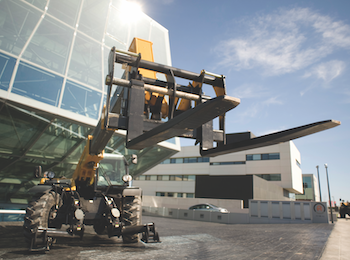 |
| Making it easier to operate safely, Haulotte telehandlers have an easy-to-view and simple-to-understand Load Moment Indicator system that actively monitors the location and weight of the load being carried. |
Making it easier to operate safely, Haulotte telehandlers have an easy-to-view and simple-to-understand Load Moment Indicator system that actively monitors the location and weight of the load being carried. If the machine is overloaded, the system automatically cuts off unsafe movements, decreasing tip-over risks.
Machine agility has increased with multiple steering modes, more compact chassis lengths and greater visibility from within the cab. More work can be done on smaller work sites while minimizing impact accidents.
There is a recognized link between operator comfort and preventable accidents. Technology inside the cab such as air conditioning, work lights, seat and control panel ergonomics work together to prevent accidents outside the cab.
There is a growing awareness of the safety and productivity that a telehandler brings to the job site. Delivery trucks are unloaded faster with fewer injuries. Materials are moved and placed at optimal locations within the project site to perform work tasks at greater speed and with fewer injuries. This means that project site logistics move at a more efficient pace and less time is spent carrying material by hand. Telehandlers make sure material is on hand at the right place at the right time to keep work progressing.
Telehandlers are a first on, last off piece of equipment on job sites. They have become essential pieces of all phases of a project, which means steady utilization and income for rental stores.
Telehandlers increase workers safety and productivity. Haulotte enclosed-ROPS cabs have superior visibility, heating and air conditioning, fully adjustable seating and an ergonomic control panel. Because the Haulotte load-sensing system is located in the rear axle, it is protected from work site damage while preventing accidents caused by overloading the machine. The hydrostatic driving system provides best-in-class comfort and accuracy to ensure workers are able to carry and place loads in the safest conditions. Operators that can work in comfort and are confident in the safe performance of their machine are safer and more productive.
Maintenance on Haulotte telehandlers is very simple. Components are easy to access. Diagnostics is fast using the under-dashboard easy-access data plug. Haulotte has a worldwide service network to support machines no matter where they are located. Finally, technicians can be trained at one of Haulotte’s technical centers or at the machine owner’s location.
Operator training helps users get the most from telehandlers
Magni focuses on providing customers with the ability to operate safer, lift higher, lift heavier, be more efficient and generate higher profits. To achieve that, Magni offers 15 rotating telehandler models with lift heights ranging from 57 to 167 feet including four models over 100 feet (114, 127, 150 and 167 feet).
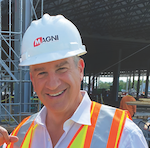 |
|
GARY WEISMAN |
They all rotate continuously 360-degrees in either direction. Magni rotating telehandlers offer world-leading lifting capacities of 11,000, 13,200, 17,600, or 28,600 pounds, depending on the model. With these heights and capacities, Magni units are often replacing hired cranes on many job sites. The units are easy to set up and don’t require special permits and can be outfitted with more than 100 attachments including a telescopic forklift, rough-terrain crane, boom lift (MEWP) and specialty units for glass placement, tree cutting and other specific jobs.
The ability to have several machines in one creates much higher utilization on the job site, and cuts down on logistics, machine movement, insurance, fuel, insurance, operators and other overhead items. This translates into greater safety, efficiency, and profit.
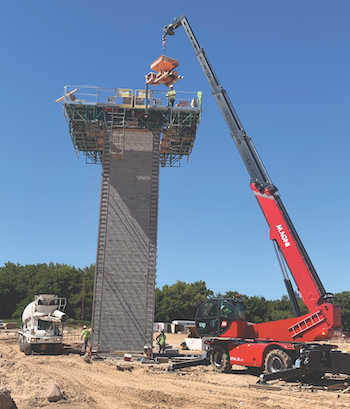 |
| Larger telehandlers are capable of lifting heavy loads to heights, improving workflow, productivity and safety. |
The Magni models have a patented cab design that provides full visibility so the operator can see everything for increased safety and efficiency. Full HVAC and 100 percent air filtration are standard equipment.
The Magni Combi Touch System is an advanced concept in machine management software. It is displayed on an easy-to-use and highly intuitive full-color touchscreen display and makes it easy for operators to manage most functions. Magni’s full-digital LMI (Load Movement Indicator), dynamic load stabilization, and automatic attachment recognition automatically loads the proper page for the attachment being used.
New Magni models come standard with the MyMagni management and monitoring system to help provide maximum utilization. This provides location, engine, maintenance, warning information and much more.
It has been proven beyond a doubt that once operators, project managers and owners experience Magni units, they keep using them. The unmatched levels of safety, efficiency and profit they receive translates into increased ROI for dealers. Because Magni models are not a commodity product and they produce important benefits to end-users, rental centers can achieve the price targets they desire. While it does take some effort on the part of the rental center to create market awareness, the effort is well rewarded.
Operator training is key to rental success with Magni units. While Magni units are very easy to learn and use, they require some up-front operator training. To accomplish that, Magni experts have developed operator familiarization and training videos, answers to the most commonly asked operator questions, and the availability of snippets over the web to allow operators easy access to answers for their questions.
Worry-free emissions systems help rental units
In recent years, the major changes in telescopic handlers focused on the engine and exhaust control systems to meet government emissions requirements. Today’s advanced systems reduce the amount of particulate matter and nitrogen oxides by 99 percent from the 1996-era diesel engine.
 |
|
STEVEN KISKUNAS |
However, those advanced engine systems result in higher cost and greater operator understanding of how to maintain and manage them. That led to increased training for operators to maintain the system and made it difficult for many rental centers to manage. Therefore, there has been a strong interest in telescopic handler products that met the new regulations but do not include the need for additional training and maintenance.
Gehl launched the Mark 74 telescopic handlers to meet this need. These machines comply with the Tier IV final government regulations without the DEF fluid or DPF regeneration systems. The Gehl Mark 74 units feature a 74 horsepower Cummins engine in the RS6-42, RS8-42, RS8-44 and RS10-55 models.
To solve the training and maintenance issue, overall engine power is lower than the standard engine for these models. Due to the lower horsepower, the Mark 74 units are recommended for applications where high speed, high torque and high altitude use is not required.
In addition to providing a product that requires less training and maintenance, the Gehl Mark 74 model retail price is lower than the higher horsepower models. This lower acquisition cost improves the ROI, as most units will rent for the same rates based on the capacity and lift performance of the machine. In addition, to improve ROI for rental telescopic handlers, Manitou experts always recommend training on machine maintenance with the rental customer before use. Telescopic handlers maintained properly while in your rental fleet will have fewer repair costs and should have higher resale valve when it is time to sell the asset.
When reviewing a customer request for a telescopic handler, it is good practice to first ask what application and materials with which the customer plans to use the machine. It helps rental centers to make sure the correct size of telescopic handler is rented for the work that needs to be done. For example, in some applications, the 6,000-pound 42-foot reach machine is a better fit for the work instead of the 8,000-pound 42-foot reach machine. Finding the correct size machine for the customer takes a little work up front, but in the long run, leads to greater customer satisfaction and return business.
The second reason to ask how the telescopic handler will be used is that there may be additional opportunities for the machine to do more work than the customer’s original request. Telescopic handlers are tool carriers and with the correct attachment, the machine can move quickly from placing lumber with a fork carriage to setting trusses with a jib, lift hook or truss boom, move gravel with a bucket or lift people in a work platform to access high areas. If additional opportunities arise, the rental time can be extended and additional rental revenue gained.
Telematics gives real-time access
Like it has within many equipment categories, telematics has emerged as a key technology for telehandlers. This is an important development for rental fleets in particular, allowing rental centers to monitor everything service related on the machine.
 |
| Mitch Fedie Marketing Manager Pettibone |
With real-time access to the status of a telehandler, many potential issues can be caught and avoided before they happen. Maintenance alerts can notify rental center personnel that it’s time for a 2,000-hour inspection, to checking battery voltage, to remotely diagnosing an engine error code.
Many customers – even those very experienced with telehandlers – aren’t always familiar with a particular brand or model, so getting those alerts can go a long way toward ensuring the customer’s uptime on a particular project and the long-term health of the telehandler in your fleet.
Proper OEM training is important for everyone on your team, from sales and account managers to service technicians, so that customers can be given proper instruction for using the machine and maintaining it daily. The boom and other components need to be greased. Tires should be inflated to the proper pressure and inspected for damage.
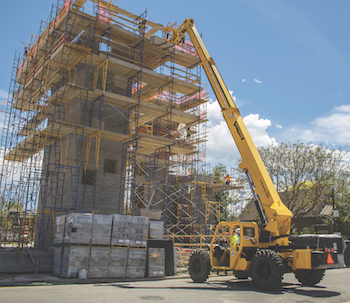 |
| Pettibone continues to be the only manufacturer producing a telehandler with a horizontally sliding boom with its Traverse lineup. The Traverse offers up to 70 inches of traversing boom travel. |
Even something like filling the diesel exhaust fluid (DEF) tank, for telehandler models that require it, is still occasionally overlooked by the user. Make sure the customer understands the need to re-fill the DEF tank so it is not running on empty. This oversight can shut down the machine, requiring a visit from a service tech to re-flash the ECU. Such a delay is costly for everyone involved.
When the telehandler returns from the job site, perform regular maintenance and simple visual inspections. Make sure the wear pads are in the correct spec to ensure smooth boom travel. Check hydraulic hoses for leaks. Regular maintenance is key to helping the machine run for a long time without any major issues. It just makes sense to maximize your investment by keeping it in good working order and ensure a quality financial return.
Other trends in telehandler technology include safety features like back-up cameras to assist with rear-view visibility. Pettibone X-Series telehandlers were specifically designed to provide clear sightlines so the operator has direct visibility around the machine when maneuvering, but the added camera can still come in handy in some circumstances.
Pettibone continues to be the only manufacturer producing a telehandler with a horizontally sliding boom with our Traverse lineup. The Traverse offers up to 70 inches of traversing boom travel. This allows it to safely land loads without having to coordinate multiple boom functions or move the machine physically forward or back, which can be hazardous, particularly on rough terrain.
The other advantage provided by Traverse is that the landing height actually matches the specified maximum lift height for the machine. With a traditional fixed boom unit, the landing height can be as much as a couple of feet lower than the advertised lift height, based on the fork positioning needed to land a load at height.
Electric-powered telehandler debuts
Snorkel is proud to be leading the industry with the introduction of the world’s first fully electric-powered telehandler. Unveiled at ConExpo/Con-Agg 2020, the Snorkel SR5719E is powered by Li-ion batteries. Completely zero emissions, this compact rough-terrain telehandler delivers equivalent performance to the diesel-powered version, yet with significantly less noise.
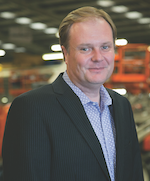 |
|
MATTHEW ELVIN |
Suitable for all types of indoor and outdoor construction and facilities maintenance tasks, the SR5719E is ideal for working in enclosed spaces, such as underground or multi-story car parks where zero emissions provide an improved working environment, and optional non-marking tires leave no trace on slab concrete floors and ramps. Additionally, with urban areas continuing to become more densely populated, the significantly reduced noise emissions from the electric SR5719E help contractors meet stricter noise pollution regulations. That also provides the potential for expanded working hours, such as overnight, thanks to less noise disruption for neighboring properties.
There is a continuing trend for telehandlers to achieve greater lifting capacities and lift heights so they can be used in more applications that would traditionally have been serviced by mobile cranes. Some customers are also requesting load management systems on telehandlers. Owners are starting to see the long-term benefits of these systems which can reduce overloads that can lead to structural failures and increased maintenance costs.
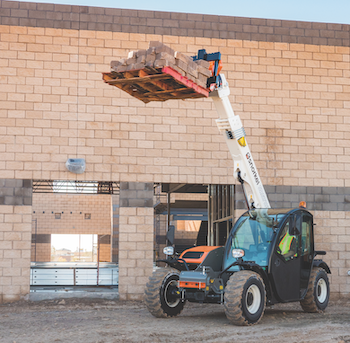 |
| The Li-ion-powered Snorkel SR5719E provides rental centers with a real opportunity to differentiate their fleet, particularly when renting telehandlers to contractors working in car park and/or underground construction, as well as industrial locations, such as plant rooms, thanks to its zero potential for fuel spillage. |
As a completely new-to-market product, the Li-ion-powered Snorkel SR5719E provides rental centers with a real opportunity to differentiate their fleet, particularly when renting telehandlers to contractors working in car park and/or underground construction, as well as industrial locations, such as plant rooms, thanks to its zero potential for fuel spillage.
The ability to use the telehandler indoors and outdoors maximizes rental opportunities, and combined with reduced noise for extended working hours, presents rental centers with an opportunity for high utilization and improved rental rates. This is supported by lower refueling costs vs. the diesel equivalent, and the ability to access green city markets, where diesel-powered units may be restricted.
An important area of focus for rental centers with telehandlers is making sure the right telehandler is selected for the job. A rental center equipment expert should conduct a job or site survey and ensure the customer rents a telehandler that meets their needs in terms of lifting capacity and reach. The rental center should also identify whether the telehandler will be used primarily for pick-and-carry, or pick-and-place applications, as this has a bearing on whether to select a telehandler with or without outriggers.
By selecting the right telehandler for the job, rental centers can ensure customer satisfaction as well as help to reduce the risk of equipment damage. Telehandlers that are subjected to lifting over-capacity loads will suffer structural fatigue more quickly, and in the short term could result in an increase in service calls.
To help avoid these challenges, rental centers should also make sure operators are trained and thoroughly familiarized with the equipment. That includes maintenance procedures and schedules. Customers must be familiar with DEF and aftertreatment requirements on diesel telehandlers to avoid potential damage to engines and unnecessary downtime or service issues on the job. Telehandlers are generally an integral piece of equipment on most job sites, used for loading, unloading and transporting materials to keep the project running. As such, telehandler breakdowns and downtime can cause significant challenges and delays for a contractor. To minimize this risk, telehandlers need to be well-maintained to maximize reliability, and the rental center needs to be ready to provide responsive service and support to telehandlers and have necessary spare parts and consumables available.
This article originally appeared in the November-December 2020 issue of Pro Contractor Rentals magazine. © 2020 Urbain Communications LLC. All rights reserved.










